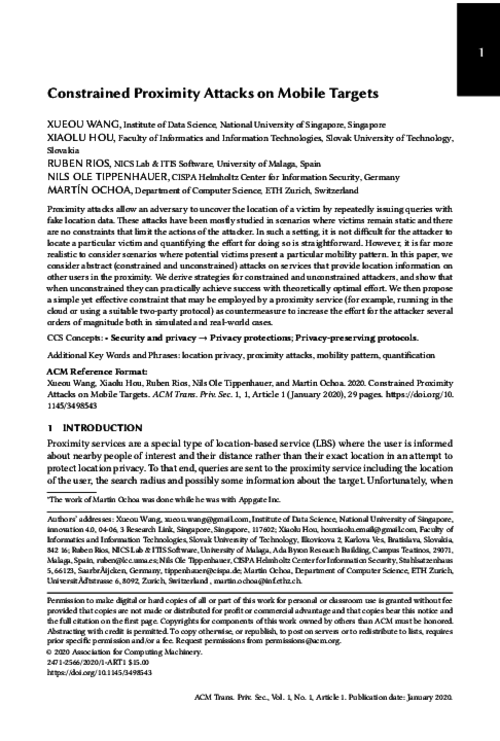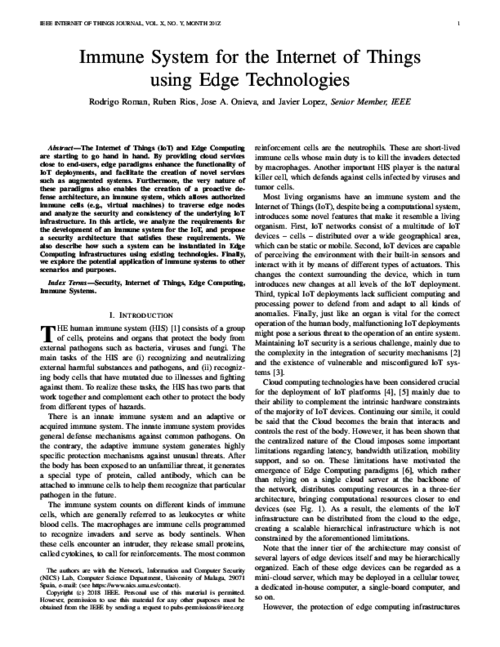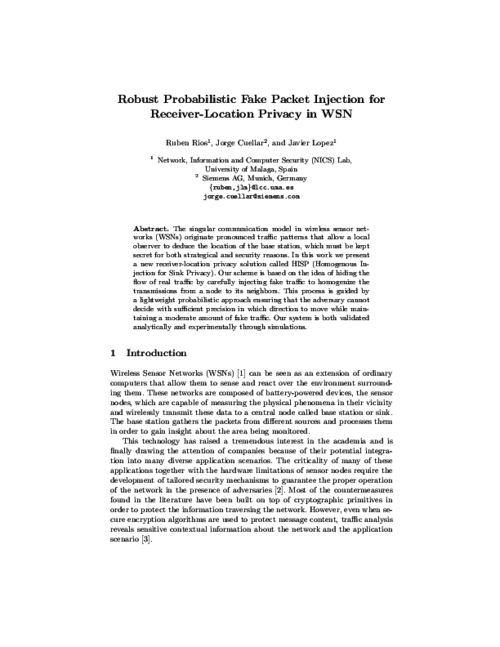Ruben Rios

Associate Professor
Edificio de Investigación Ada Byron
C/ Arquitecto Francisco Peñalosa, nº 18
Ampliación Campus de Teatinos. Universidad de Málaga
29071 Málaga (Spain)
Phone: +34 951 952 939
E-mail: ruben.rdp@uma.es
Domain of interest and research
- Privacy-Enhancing Technologies
- Covert Communication Channels
- Edge Computing Security
Education
- PhD in Computer Science (University of Málaga, Spain, 2014)
- MSC in Computer Science (University of Málaga, Spain, 2008)
- BSc in Computer Science (University of Skövde, Sweden, 2007)
Relevant Publications
Xueou Wang, Xiaolu Hou, Ruben Rios, Nils Ole Tippenhauer, Martin Ochoa
Constrained Proximity Attacks on Mobile Targets Journal Article
In: ACM Transactions on Privacy and Security (TOPS), vol. 25, no. 10, pp. 1 – 29, 2022, ISSN: 2471-2566.
@article{rios2022cpa,
title = {Constrained Proximity Attacks on Mobile Targets},
author = {Xueou Wang and Xiaolu Hou and Ruben Rios and Nils Ole Tippenhauer and Martin Ochoa},
url = {/wp-content/papers/rios2022cpa.pdf},
doi = {10.1145/3498543},
issn = {2471-2566},
year = {2022},
date = {2022-05-01},
urldate = {2022-05-01},
journal = {ACM Transactions on Privacy and Security (TOPS)},
volume = {25},
number = {10},
pages = {1 - 29},
publisher = {Association for Computer Machinery (ACM)},
abstract = {Proximity attacks allow an adversary to uncover the location of a victim by repeatedly issuing queries with fake location data. These attacks have been mostly studied in scenarios where victims remain static and there are no constraints that limit the actions of the attacker. In such a setting, it is not difficult for the attacker to locate a particular victim and quantifying the effort for doing so is straightforward. However, it is far more realistic to consider scenarios where potential victims present a particular mobility pattern. In this paper, we consider abstract (constrained and unconstrained) attacks on services that provide location information on other users in the proximity. We derive strategies for constrained and unconstrained attackers, and show that when unconstrained they can practically achieve success with theoretically optimal effort. We then propose a simple yet effective constraint that may be employed by a proximity service (for example, running in the cloud or using a suitable two-party protocol) as countermeasure to increase the effort for the attacker several orders of magnitude both in simulated and real-world cases.},
keywords = {},
pubstate = {published},
tppubtype = {article}
}

Ruben Rios
Recipient Anonymity Book Chapter
In: Sushil Jajodia, Pierangela Samarati, Moti Yung (Ed.): 2021.
BibTeX | Links:
@inbook{Rios2024,
title = {Recipient Anonymity},
author = {Ruben Rios },
editor = {Sushil Jajodia and Pierangela Samarati and Moti Yung},
doi = {10.1007/978-3-642-27739-9},
year = {2021},
date = {2021-12-23},
urldate = {2024-07-12},
keywords = {},
pubstate = {published},
tppubtype = {inbook}
}
Rodrigo Roman, Ruben Rios, Jose A. Onieva, Javier Lopez
Immune System for the Internet of Things using Edge Technologies Journal Article
In: IEEE Internet of Things Journal, vol. 6, pp. 4774-4781, 2019, ISSN: 2327-4662.
@article{roman2018VIS,
title = {Immune System for the Internet of Things using Edge Technologies},
author = {Rodrigo Roman and Ruben Rios and Jose A. Onieva and Javier Lopez},
url = {/wp-content/papers/roman2018VIS.pdf
https://ieeexplore.ieee.org/document/8449989/},
doi = {10.1109/JIOT.2018.2867613},
issn = {2327-4662},
year = {2019},
date = {2019-06-01},
urldate = {2019-06-01},
journal = {IEEE Internet of Things Journal},
volume = {6},
pages = {4774-4781},
publisher = {IEEE Computer Society},
abstract = {The Internet of Things (IoT) and Edge Computing are starting to go hand in hand. By providing cloud services close to end-users, edge paradigms enhance the functionality of IoT deployments, and facilitate the creation of novel services such as augmented systems. Furthermore, the very nature of these paradigms also enables the creation of a proactive defense architecture, an immune system, which allows authorized immune cells (e.g., virtual machines) to traverse edge nodes and analyze the security and consistency of the underlying IoT infrastructure. In this article, we analyze the requirements for the development of an immune system for the IoT, and propose a security architecture that satisfies these requirements. We also describe how such a system can be instantiated in Edge Computing infrastructures using existing technologies. Finally, we explore the potential application of immune systems to other scenarios and purposes.},
keywords = {},
pubstate = {published},
tppubtype = {article}
}
Javier Lopez, Ruben Rios, Feng Bao, Guilin Wang
Evolving privacy: From sensors to the Internet of Things Journal Article
In: Future Generation Computer Systems, vol. 75, pp. 46–57, 2017, ISSN: 0167-739X.
@article{Lopez2017iotpriv,
title = {Evolving privacy: From sensors to the Internet of Things},
author = {Javier Lopez and Ruben Rios and Feng Bao and Guilin Wang},
url = {/wp-content/papers/Lopez2017iotpriv.pdf},
doi = {10.1016/j.future.2017.04.045},
issn = {0167-739X},
year = {2017},
date = {2017-10-01},
urldate = {2017-10-01},
journal = {Future Generation Computer Systems},
volume = {75},
pages = {46\textendash57},
publisher = {Elsevier},
abstract = {The Internet of Things (IoT) envisions a world covered with billions of smart, interacting things capable of offering all sorts of services to near and remote entities. The benefits and comfort that the IoT will bring about are undeniable, however, these may come at the cost of an unprecedented loss of privacy. In this paper we look at the privacy problems of one of the key enablers of the IoT, namely wireless sensor networks, and analyse how these problems may evolve with the development of this complex paradigm. We also identify further challenges which are not directly associated with already existing privacy risks but will certainly have a major impact in our lives if not taken into serious consideration.},
keywords = {},
pubstate = {published},
tppubtype = {article}
}
Ruben Rios, David Nuñez, Javier Lopez
Query Privacy in Sensing-as-a-Service Platforms Proceedings Article
In: Sabrina De Capitani Vimercati, Fabio Martinelli (Ed.): 32nd International Conference on ICT Systems Security and Privacy Protection (IFIP SEC 2017), pp. 141–154, Springer Springer, Roma, Italy, 2017.
@inproceedings{Rios2017query,
title = {Query Privacy in Sensing-as-a-Service Platforms},
author = {Ruben Rios and David Nu\~{n}ez and Javier Lopez},
editor = {Sabrina De Capitani Vimercati and Fabio Martinelli},
url = {/wp-content/papers/Rios2017query.pdf},
doi = {10.1007/978-3-319-58469-0_10},
year = {2017},
date = {2017-05-01},
urldate = {2017-05-01},
booktitle = {32nd International Conference on ICT Systems Security and Privacy Protection (IFIP SEC 2017)},
volume = {502},
pages = {141\textendash154},
publisher = {Springer},
address = {Roma, Italy},
organization = {Springer},
series = {IFIP Advances in Information and Communication Technology (AICT)},
abstract = {The Internet of Things (IoT) promises to revolutionize the way we interact with the physical world. Even though this paradigm is still far from being completely realized, there already exist Sensing-as-a-Service (S^2aaS) platforms that allow users to query for IoT data. While this model offers tremendous benefits, it also entails increasingly challenging privacy issues. In this paper, we concentrate on the protection of user privacy when querying sensing devices through a semi-trusted S^2aaS platform. In particular, we build on techniques inspired by proxy re-encryption and k-anonymity to tackle two intertwined problems, namely query privacy and query confidentiality. The feasibility of our solution is validated both analytically and empirically.},
keywords = {},
pubstate = {published},
tppubtype = {inproceedings}
}

Ruben Rios, Javier Lopez, Jorge Cuellar
Location Privacy in Wireless Sensor Networks Book
Taylor & Francis, 2016, ISBN: 9781498776332.
BibTeX | Links:
@book{Rios2016,
title = {Location Privacy in Wireless Sensor Networks},
author = {Ruben Rios and Javier Lopez and Jorge Cuellar},
url = {https://www.crcpress.com/Location-Privacy-in-Wireless-Sensor-Networks/Rios-Lopez-Cuellar/p/book/9781498776332},
isbn = {9781498776332},
year = {2016},
date = {2016-01-01},
urldate = {2016-01-01},
publisher = {Taylor \& Francis},
organization = {Taylor \& Francis},
series = {CRC Series in Security, Privacy and Trust},
keywords = {},
pubstate = {published},
tppubtype = {book}
}
Ruben Rios, Jorge Cuellar, Javier Lopez
Robust Probabilistic Fake Packet Injection for Receiver-Location Privacy in WSN Proceedings Article
In: Sara Foresti, Moti Yung, Fabio Martinelli (Ed.): 17th European Symposium on Research in Computer Security (ESORICS 2012), pp. 163-180, Springer Springer, Pisa, Italy, 2012, ISSN: 0302-9743.
@inproceedings{Rios2012d,
title = {Robust Probabilistic Fake Packet Injection for Receiver-Location Privacy in WSN},
author = {Ruben Rios and Jorge Cuellar and Javier Lopez},
editor = {Sara Foresti and Moti Yung and Fabio Martinelli},
url = {/wp-content/papers/Rios2012d.pdf},
doi = {10.1007/978-3-642-33167-1_10},
issn = {0302-9743},
year = {2012},
date = {2012-09-01},
urldate = {2012-09-01},
booktitle = {17th European Symposium on Research in Computer Security (ESORICS 2012)},
volume = {7459},
pages = {163-180},
publisher = {Springer},
address = {Pisa, Italy},
organization = {Springer},
series = {LNCS},
abstract = {The singular communication model in wireless sensor networks (WSNs) originate pronounced traffic patterns that allow a local observer to deduce the location of the base station, which must be kept secret for both strategical and security reasons. In this work we present a new receiver-location privacy solution called HISP (Homogenous Injection for Sink Privacy). Our scheme is based on the idea of hiding the flow of real traffic by carefully injecting fake traffic to homogenize the transmissions from a node to its neighbors. This process is guided by a lightweight probabilistic approach ensuring that the adversary cannot decide with sufficient precision in which direction to move while maintaining a moderate amount of fake traffic. Our system is both validated analytically and experimentally through simulations.},
keywords = {},
pubstate = {published},
tppubtype = {inproceedings}
}
The full list of publications can be accessed here.
Attended courses and seminars
- FOSAD 2013: 13th International School on Foundations of Security Analysis and Design. Bertinoro, Italy (2013)
- Control Systems Security Models, Malaga, Spain (2010)
- Service Protocol Verification, Malaga, Spain (2010)
- IPICS 2009: Intensive Programme on Information and Communication Security. Viena, Austria (2010)
- SWING 2009: 4th Bertinoro PhD School on Security of Wireless Networking. Bertinoro, Italy (2009)
- Security and Privacy for wireless resource constrained devices, University of Malaga, Spain (2009)
- SWING 2008: 3rd Bertinoro PhD School on Security of Wireless Networking. Bertinoro, Italy (2008)
Scientific Activities
- General Chair
- 2019: EuroSPEC
- Program (co)Chair
- Organization committee member:
- Program committee member (most recent ones):
- Editorial Board:
- Security and Privacy, John Wiley & Sons
Memberships
- Member of UNE CTN 320/SC5 (Spanish Mirror of ISO/IEC JTC 1/SC 27)
- IEEE Member






